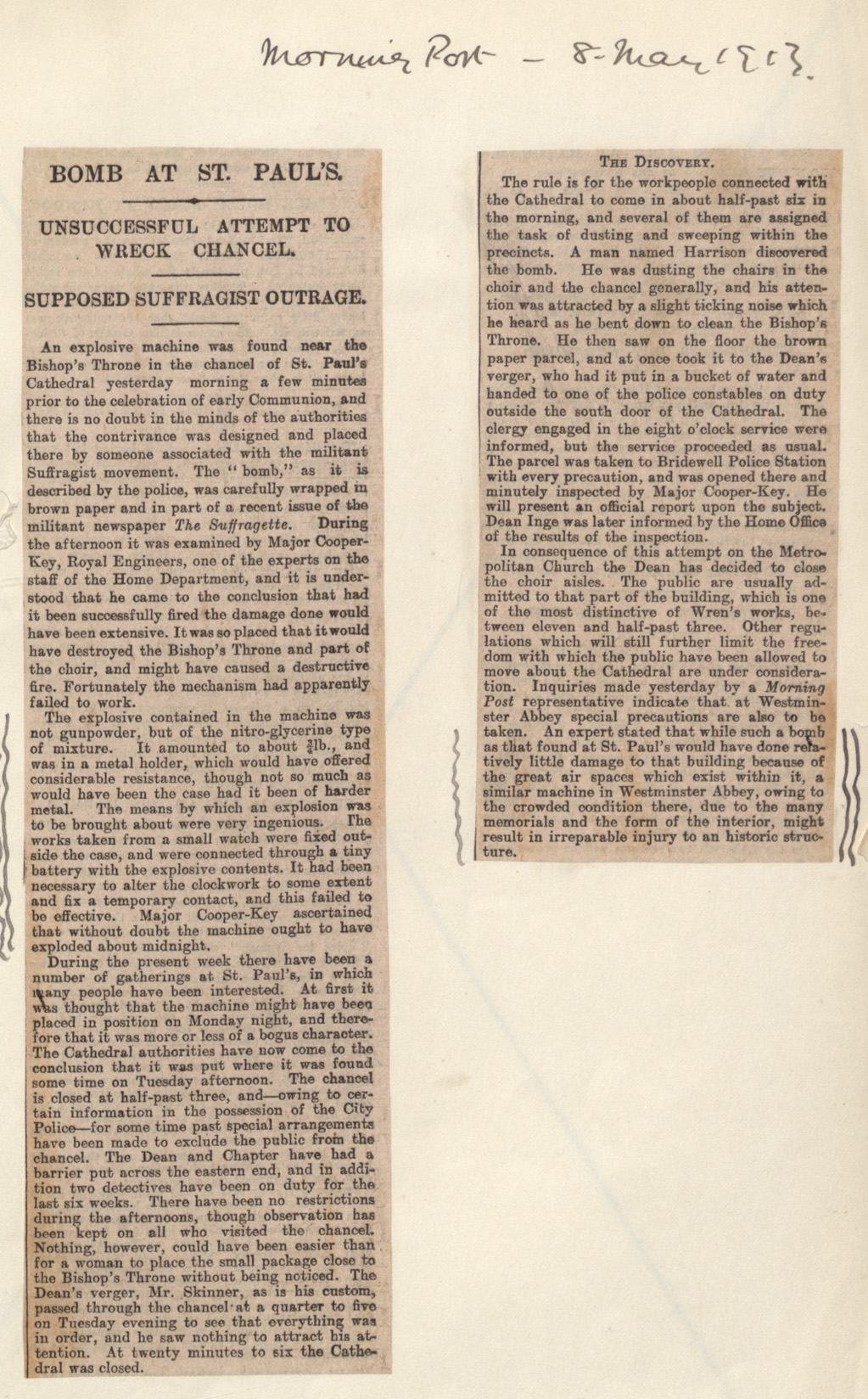
Extract from the Morning Post about an attempt to bomb the chancel at St Paul’s Cathedral, 8 May 1913 (Catalogue ref: HO 45/10700/236973)
Transcript
BOMB AT ST. PAUL’S
UNSUCESSFUL ATTEMPT TO WRECK CHANCEL
SUPPOSED SUFFRAGIST OUTRAGE
An explosive machine was found near the Bishop’s Throne in the chancel of St. Paul’s Cathedral yesterday morning a few minutes prior to the celebration of early Communion, and there is now no doubt in the minds of the authorities that the contrivance was designed and placed there by someone associated with the militant Suffragist movement. The “bomb” as it is described by the police, was carefully wrapped in brown paper and in part of a recent issue of the militant newspaper, The Suffragette. During the afternoon it was examined by Major Cooper-Key, Royal Engineers, one of the experts on the staff of the Home Department, and it is understood that he came to the conclusion that had it been successfully fired the damage done would have been extensive. It was so placed that it would have destroyed the Bishop’s Throne and part of the choir, and might have caused a destructive fire. Fortunately the mechanism had apparently failed to work.
The explosive contained in the machine was not gunpowder, but of the nitro-glycerine type of mixture. It amounted to about 3/4lb. and was in a metal holder, which would have offered considerable resistance, though not as much as would have been the case had it been of harder metal. The means by which an explosion was to be brought about were very ingenious. The works taken from a small watch were fixed outside the case, and were connected through a tiny battery with the explosive contents. It had been necessary to alter the clockwork to some extent and fix a temporary contact, and this had failed to effective. Major Cooper-Key ascertained that without doubt the machine ought to have been exploded about midnight.
During the present week there have been a number of gatherings at St Paul’s, in which many people have been interested. At first it was thought that the machine might have been placed in position on Monday night, and therefore that it was more or less of a bogus character. The Cathedral authorities have now come to the conclusion that it was put where it was found some time on Tuesday afternoon. The chancel is closed at half-past three, and-owing to certain information in the possession of the City Police-for some time past special arrangements have been made to exclude the public from the chancel. The Dean and Chapter have had a barrier put across the eastern end, and in addition two detectives have been on duty for the last six weeks. There have been no restrictions during the afternoons though observation has been kept on all who visited the chancel. Nothing, however could be easier than for a woman to place the small package close to the Bishop’s Throne without being noticed. The Dean’s verger. Mr. Skinner, as is his custom, passed through the chancel at a quarter to five on Tuesday evening to see that everything was in order, and he saw nothing to attract his attention. At twenty minutes to six the Cathedral was closed.
THE DISCOVERY
The rule is for the workpeople connected with the Cathedral to come in about half-past six in the morning, and several of them are assigned the task of dusting and sweeping within the precincts. A man named Harrison discovered the bomb. He was dusting the chairs in the choir and the chancel generally, and his attention was attracted by a slight ticking noise which he heard as he bent down to clean the Bishop’s Throne. He then saw on the floor the brown paper parcel, and at once took it to the Dean’s verger, who had put it in a bucket of water and handed to one of the police constables on duty outside the south door of the Cathedral. The clergy engaged in the eight o’clock service were informed, but the service proceeded as usual. The parcel was taken to Bridewell Police Station with every precaution, and was opened there and minutely inspected by Major Cooper-Key. He will present an official report upon the subject. Dean Inge was later informed by the Home Office of the results of the inspection.
In consequence of this attempt on the Metropolitan Church, the Dean has decided to close the choir aisles. The public are usually admitted to that part of the building, which is one of the most distinctive of Wren’s work, between eleven and half-past three. Other regulations which still further limit the freedom with which the public have been allowed to move about the Cathedral are under consideration. Inquiries made yesterday by a Morning Post representative indicate that at Westminster Abbey special precautions are also to be taken. An expert stated that while such a bomb as that found at St Paul’s would probably have done relatively little damage to that building because of the great air spaces which exist within it, a similar machine in Westminster Abbey, owing to the crowded condition there, due to the many memorials and the form of the interior, might result in irreparable injury to an historic structure.
